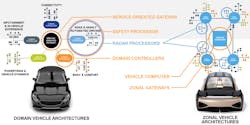What’s the Difference Between Domain and Zonal Automotive Architectures?
Many embedded solutions are designed around a domain-oriented approach—specific modules provide a function and controlled devices or sensors are wired to the module, often called electronic control units (ECUs). This works well in many applications, especially where the computation can be performed locally.
Such an approach can scale well if the devices and sensor placement remain close to the module, with additional modules being added to handle more devices and sensors. For example, a computer-controlled motor-control system that’s paired with the motor would scale nicely if an application needed a number of motors.
It becomes more challenging if sensors and devices are farther from the control module because of the additional wiring and interfacing that’s involved in the solution. Cabling becomes a major issue as more sensors and devices are added to the mix.
This is the case in many automotive applications. Thus, a networked-zone approach can provide better scalability as well as improved reliability and functionality. Typically, a central compute complex is linked to the sensors and devices through networked zonal gateways (see figure).
The network connections these days tend to be Ethernet. This includes various forms of automotive Ethernet. The zonal gateways aren’t just network switches, although the system-on-chip (SoC) solutions that are often used to implement a gateway will have an integrated network switch.
The zonal architecture scales better for numerous reasons, including providing a backbone for a software-driven framework. The approach simplifies cabling: Gateways are closer to sensors and devices they will be working with, and cabling between gateways and hosts is less complex.
Local processing at a gateway is possible. However, the flexibility is provided by the high-speed network links that can move data to and from the outer sensor and device environment to the heavy-duty compute servers located anywhere within the car.
This structural paradigm shift is in line with the movement to distributed software functionality and the ability to provide enhancements with new software.


